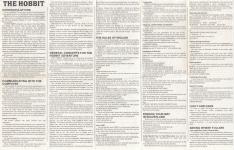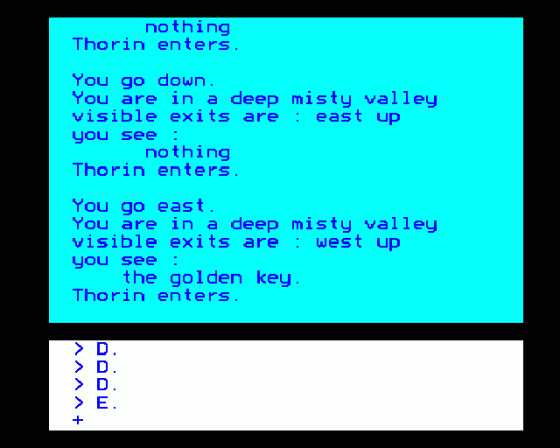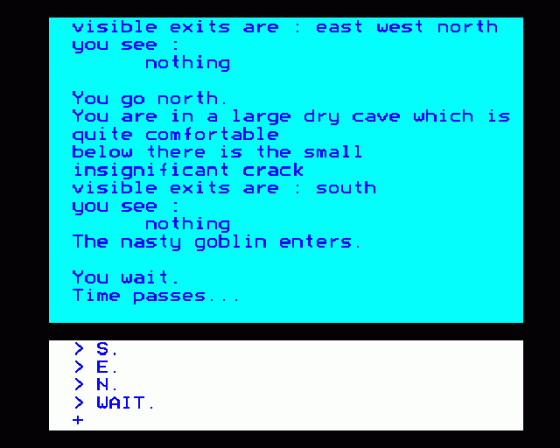Alternative Games Called The Hobbit
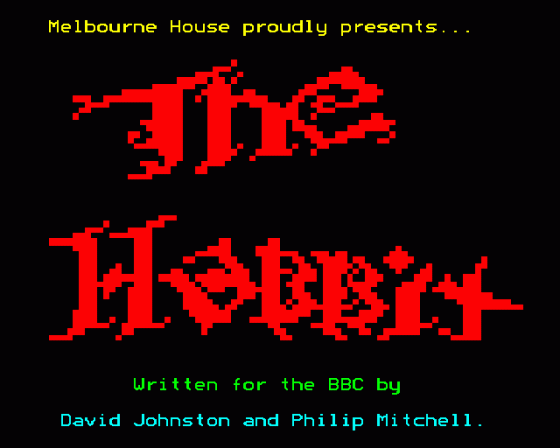
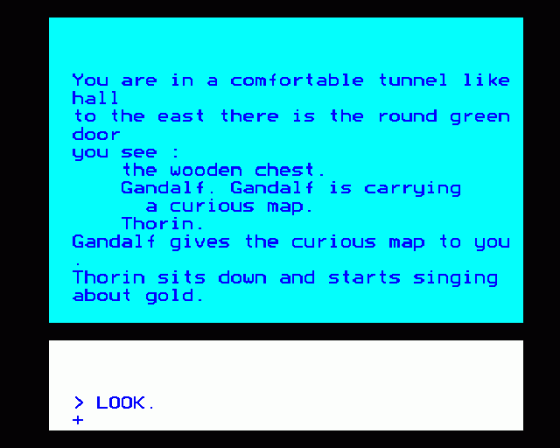
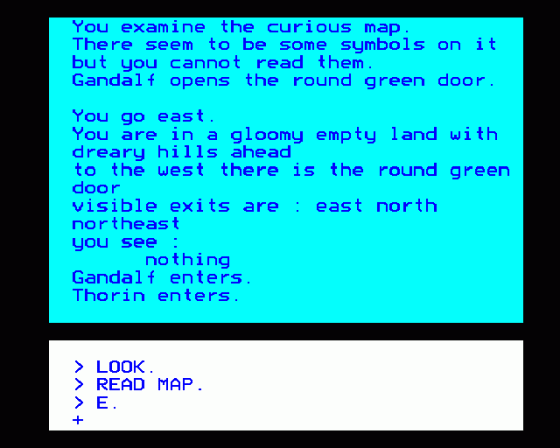

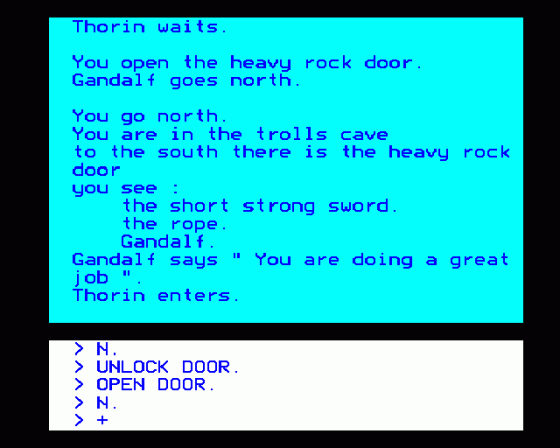
| Genre: | Adventure Game: Text/Illustrated |
| Publisher: | Melbourne House |
| Cover Art Language: | English |
| Machine Compatibility: | BBC Model B |
| Release: | Professionally released on Cassette |
| Available For: | Amstrad CPC464, BBC Model B, Commodore 64/128, Oric 48K, Spectravideo 328 & Spectrum 48K/128K |
| Compatible Emulators: | BeebEm (PC (Windows)) PcBBC (PC (MS-DOS)) Model B Emulator (PC (Windows)) |
| Original Release Date: | 1st December 1985 |
| Original Release Price: | Unknown |
| Market Valuation: | £2.50 (How Is This Calculated?) |
| Item Weight: | 98g |
| Box Type: | Cassette Double Plastic Clear |
| Author(s): | David Johnston, Veronika Megler, Philip Mitchell, Peter Beresford & Geoff Halprin |
Variant Items
There are 2 other items featuring this same game (that we know about!). Click any of them for their details.
Active Auctions
Closed Auctions
Buy It
Unfortunately no-one is currently selling this item.
Auction Price Watch
Worried you're being ripped off? Closing prices on eBay can help you decide what a reasonable price is for a particular item.
Screenshots
Authors: David Johnston, Veronika Megler, Philip Mitchell, Peter Beresford & Geoff Halprin

Acorn User
1st December 1985
Adventure addicts will adore The Hobbit, but even those who, like myself, are very choosy when it comes to adventures, will enjoy it thoroughly. Read Review

Computer Gamer
1st September 1985
One of the best versions of an incredibly good game... the equivalent of a 200K game. There's certainly nothing better for the Beeb that I have seen...! Read Review

Games Computing
1st August 1984
The lack of illustrations in this version doesn't really affect the adventure itself but it does take far too long to load from cassette. Read Review

Home Computing Weekly
10th January 1984
Fifteen pounds seems a bit steep... but The Hobbit will give rich adventure fans many hours of brain-racking fun. Read Review

Home Computing Weekly
23rd July 1985
Heavily reliant on disc-usage... The constant accessing is tedious... Pictures are not even all that good... I wouldn't bother rushing out to buy this one. Read Review
Full Instructions
Congratulations
Congratulations! You are about to play the most sophisticated game program yet devised for any microcomputer.
Melbourne House, in association with the Tolkien Estate, are very proud to be able to present to you The Hobbit, an amazing program based on J.R.R. Tolkien's brilliant fantasy novel.
In The Hobbit program, you take on the role of Bilbo, the hobbit. You will be able to roam freely throughout Middle Earth, explore and discover this wonderful enchanted land. You will meet all type of creatures, some friendly, others much less so. Your adventure will be dangerous and exciting - it will be up to you to face the challenges which confront Bilbo.
If you are unfamiliar with hobbits, you should know that hobbits are a little people, about half our height, and smaller than the bearded dwarves. Hobbits have no beards. There is little or no magic about them. For a fuller description you will have to read The Hobbit, but this description should be enough for you to realise that most other creatures you will meet in this Adventure, including dwarves, will be bigger and stronger than you.
You will therefore need to exercise all your cunning and skill to survive.
At the point where this Adventure commences Gandalf, who is a wizard, has talked you into entering a new and exciting adventure to help out Thorin, the dwarf.
Your mission is to seek out the evil Dragon and return the treasure he hoards back to your home and place it for safe keeping in the chest. As a secondary mission, you must look out after Thorin and protect him. Should he be killed during the Adventure, it is most unlikely you will be able to survive the dangers ahead of you on your journey!
Best of luck Bilbo: may you return with wonderful tales to tell on a cold evening in front of a log fire.
Communicating With The Computer
The computer in this Adventure acts as a go-between for you. You tell the computer in plain "Inglish" exactly what you want to do, and the computer will translate that request and execute it.
The computer will also be your source of information about where you are, what you can see and what the other creatures in the Adventure are doing.
If the computer is not sure of something you meant, or if there is any ambiguity about what you said, it will come back to you with queries for clarification.
The computer has a large vocabulary - it knows over 500 words, and can perform over 50 different actions (made up by over 30 verbs listed at the back of this booklet, combined with over 10 prepositions) so it is capable of very sophisticated communication. The use of plain Inglish allows you to enter your instruction in normal sentences.
The Screen Display
The screen display has been divided into two "windows".
The bottom five lines of the screen is your "communication window" with the computer. Everything you type will be shown here in capital letters, and this part of the screen will scroll independently of the rest of the screen. If for some reason there is confusion about what you typed in, the computer will prompt you in the same "communication window" area.
An obvious example is where you mistype a word, such as DOOR - the computer would return with the prompt 'I don't understand the word "DOR".'
Other messages will also be printed here when the computer is not able to execute what you typed in.
The rest of the screen is the "Adventure window" - this is where you will be able to find out what is happening in the Adventure, what you can see and so on.
The "Adventure Window" is shown on the screen in upper and lower case. Every action that you take is also printed on the "Adventure window" (usually in more detail than what you entered!)
Any action that takes place, whether performed by you or one of the other characters will be shown:
"You take the short, strong sword." "Thorin examines the curious map."
Descriptions of the location, objects, what is in the object, and so on, is also shown on the "Adventure window".
The "Adventure window" scrolls independently of the bottom screen. Usually what happens will be able to be printed on the screen without losing anything. Occassionally, such as if you have typed in many sentences at once, or if there is a lot of action going on, the information will take up more than one screen full.
The screen scrolling speed is slow enough to be able to be read at normal reading speed. You may however want to examine a particular message more carefully - holding down any key will stop the scrolling. Taking your hand off the key will return to normal scrolling speed.
General Concepts For The Hobbit Adventure
The Hobbit Adventure is an adventure simulation where you have to instruct Bilbo on what to do in various situations.
The map of Wilderland, where the action takes place, can be found in the book of The Hobbit, and over 50 of the locations described in the book are represented in this Adventure.
On first entering a new location, the computer will give you a full description of where you are, and what the place looks like. You will also be given a list of the visible exits from where you are. It is a good idea to draw a map of the way the different locations connect to each other, should you need to go back or if you should get lost.
The second time you arrive at any location, the computer will give you only a short description of where you are. If you want a complete description again, you can obtain it by asking the computer to have a look around. It's that simple.
On your adventure you will find many strange and wonderful objects. Some may have magical properties, while others may not be what they first seem to be! Some can be used as weapons, others can be eaten, and so on.
There are, however, certain general laws of physics in Wilderland that must be obeyed:
- You cannot lift any object that is too heavy, or, if you are carrying too much, lift another object if that would mean carrying too heavy a load. The same obviously applies to all the other creatures in the Adventure, but as they are likely to be stronger than you are, they may be able to lift things you can't.
- You do not have to be carrying an object to be able to use it. For example, if there is a sword lying on the ground, you can say "KILL THE GOBLIN WITH THE SWORD". The major exception is if the sword (or any other object you want to do something with) is carried by someone else - as everyone else is stronger than you, they won't let you take anything they are carrying.
- Some objects can act as containers - for example, sacks, barrels, and so on! You cannot put an object into a container if it's too large to fit, nor can you put in or take out any objects if the container is closed.
- Some containers may be transparent, while others are not. You will be able to see the contents of any transparent container, but if it is not transparent, you will not be able to see inside it unless you open it.
- Liquids behave just like liquids - this means that you can't carry them around without putting them in a container, if the container breaks the liquid spills to the ground, and so on.
- Some things may be locked - doors are obvious examples, but so may windows, secret caches, and so on. To unlock them you will need the right key.
- Some things are breakable, and you must be careful in how you handle them. In other cases, you may want to deliberately break an object. Be careful what you try to break things with, because you may find that trying to break a door with a bottle, for example, will result in the bottle being broken instead!
- Fighting makes you weaker, as it requires so much energy. You will need to eat regularly to get your strength back, as otherwise you may find yourself too weak to lift even the smallest object. Be warned though - don't be a glutton.
The Rules Of Inglish
With the help of this program, your program is now able to talk to you in "Inglish". What's more, you will be able to talk to the computer in Inglish, and it will understand what you say!
Inglish is the most sophisticated natural language recognition program yet developed on any micro-computer, and Melbourne House are very proud to be able to bring this implementation to you in The Hobbit program.
The rules of Inglish are simple - you probably already know Inglish without even being aware of it.
-
Each sentence must have a verb. As a minimum sentence, you can have just the verb. For example: RUN, CLIMB, WAIT. These sentences are all fine.
The meaning of the verbs may be altered by the use of adverbs such as:
RUN QUICKLY or VICIOUSLY BREAK THE DOOR -
Normal grammar applies, and the order of the different parts of the sentence is not critical. For example, the following two sentences are both valid, and both have the same meaning:
WITH THE SWORD CAREFULLY ATTACK THE TROLL
ATTACK THE TROLL CAREFULLY WITH THE SWORD -
Adjectives which describe objects must come before the noun. If it sounds right, it probably is right.
OPEN THE GREEN DOOR is right
but OPEN THE DOOR GREEN is not.This is pretty obvious. If it sounds odd to you, you can be sure the computer is likely to think so too.
-
Prepositions, such as WITH, UNDER, ON, OFF and so on, usually come before the noun in Inglish:
ATTACK WITH THE SWORD
PICK UP THE GOLDThere are some verbs where the preposition could go before or after, or where the most natural sounding sentence is with the preposition last. For example in:
TURN THE LIGHT ON
PICK THE GOLD UP
These are also acceptable.
Use Of AND
You can use the word "AND" in all its normal meaning in Inglish! This means, along other things, that you can enter more than one sentence at a time.
The following sentences illustrate different meanings of the word "AND":
TAKE THE LAMP AND THE ROPE OUT OF THE BARREL
DROP THE SHORT AND THE LONG SWORDS
TAKE THE MONEY AND RUN
With the user of Inglish, your computer will be able to understand all these sentences correctly!
Punctuation
Different sentences should be separated by some sort of punctuation - use AND, commas, semi-colons, and full stops as you normally would.
The only limitation placed by the computer on how many sentences you can enter at one time is a total limit of 128 characters.
Of course, keep in mind that each time you do something, the other creatures may also decide to do something and you could end up with some unexpected results if you enter too many commands at once.
Using ALL, EVERYTHING And EXCEPT
It may not be convenient for you to enter the description of every object in the room if you should wish to pick everything up.
Therefore, you can generalise by the use of ALL, EVERYTHING and EXCEPT, just as you normally would.
You may qualify what you actually want to manipulate - in other words you can say ALL DWARVES, or you can say EVERYTHING EXCEPT GREEN BOTTLES.
The following are examples of valid sentences:
EAT EVERYTHING
OPEN ALL EXCEPT THE GREEN BOTTLE
BREAK ALL BOTTLES EXCEPT THE GREEN ONE
Limitations Of Inglish
-
To describe an object, you can only use the object's name and its adjectives (if any). For example, if you see that there is some delicious foaming beer in a bottle you could say:
DRINK BEER
or
DRINK DELICIOUS BEER
or
DRINK FOAMING BEER
or
DRINK DELICIOUS FOAMING BEER
or
DRINK FOAMING DELICIOUS BEERAll these would result in quenching your thirst. You cannot use the position of an object as its description. This means that a sentence such as
DRINK BEER BOTTLE
is not acceptable. -
You cannot have more than one indirect object in a sentence. Basically, this means that you cannot specify doing one thing in more than one way. For example, you could say:
PUT THE ROPE ON THE TABLE
or you could decide to put it on the chair:PUT THE ROPE ON THE CHAIR
but you cannot put the rope on both the table and on the chair at the same time. You therefore can't say:PUT THE ROPE ON THE TABLE AND CHAIR
This is a general rule, and means that you can't say things like: ATTACK THE WOLVES WITH EVERYTHING
We feel that these limitations are fairly minor, and that you should be able to express yourself exactly the way you feel most comfortable.
Finding Your Way In Wilderland
There are a number of ways you can tell the computer that you want to move from one location to another. Let's assume that you are at home (Bilbo's home, that is), and the computer tells you:
You are in a comfortable tunnel-like hall
To the east there is a green door
You can do any one of the following, all of which are valid.
Using Special Keys for Fast Movements (see last two panels overleaf for identification of these keys and additional notes)
These four keys can be used for fast movements in the main directions: north, east, south and west.
Note that these four keys can only be used as the first key of your command to the computer. You may not, for example, start entering a word, backspace to the beginning of the line and then press one of these keys.
Note also that these keys cannot move you in other directions, such as south-east, up or down.
Specifying The Direction
The eight directions of the compass (north, northeast, east, southeast, and so on...) and up and down can be specified either by their full spelling, or by abbreviation, or in a sentence.
For example: E. EAST. GO EAST. RUN EAST. QUICKLY GO EAST. are all valid
As you may enter more than one sentence at a time, you can use the directions as part of a longer command, such as:
TAKE EVERYTHING AND GO EAST
or TAKE ALL, E
If you are very brave, you can try:
E, E, SE, W
Passing Through Entrances
If you want to go through an entrance or passageway, it is quite valid to say, as in ths case, GO THROUGH THE GREEN DOOR.
You may also go through window, or any other open passageways.
An interesting point is that you can also LOOK THROUGH doors and windows. This can be very useful if you want to see where you would get to by going in that direction, or to see who is there waiting for you!
Entering Places
If you know where you are going, you can specify the location: as you well know, going east from your home leads you to the loneland.
You may therefore say:
ENTER LONELAND
or
GO INTO LONELANDS
Following Other People
If you know, as in this case, that someone you want to talk to has gone out, you can follow them:
FOLLOW GANDALF
Special Crossings
Crossing rivers, ravines, chasms and so on can be both dangerous and difficult.
You could try to jump across or swim across a river - in some cases, you may be able to use material you find to build a temporary bridge, or use a rope to swing across.
The general instructions for such a crossing would be to secure your means of crossing, and then to CROSS RAVINE.
Light And Dark
In order to reach the Dragon and his treasure, you'll need to go through caves, dungeons and other underground locations.
Some places have natural light, while others are dark and forbidding. It goes without saying that if you go into a location without a light, you won't be able to see anything.
However, you are likely to be disoriented and lose your sense of direction - it is very dangerous to move in the dark.
Special Commands
There are a number of special commands that are unique to The Hobbit adventure. These are:
LOOK (or abbreviation L):
This gives you a full description of where you are, all exists, and all visible objects except for what you are carrying.
INVENTORY (or abbreviation I):
This gives you a description of everything you are carrying.
EXAMINE object:
This enables you to have a closer look at any object you may encounter.
WAIT:
This allows the passage of time.
@:
(does not require RETURN key to be pressed)
This is an exceptionally useful key which performs the function of "DO LAST COMMAND AGAIN". This command can only be used as the first entry in a line.
PRINT:
This command turns on your printer (if you have one connected to your computer), and sends the contents of "Adventure window" to the printer as well as to the screen.
This is very useful in trying to solve the problem of The Hobbit, as it allows you to go over the events of the day at your leisure. The printout of the "Adventure window" makes excellent reading - comparable to a novel, but one in which you decide on the course of action.
NO PRINT:
This command disables the PRINT printer function.
SAVE:
This command allows you to save the data about your Adventure thus far onto tape for later playing. When you have finished SAVEing your progress thus far, the game continues normally. The SAVE feature is very useful if you have progressed deep into Wilderland and don't want to start from the beginning again should you accidentally get killed.
LOAD:
This command loads from tape the previously saved Adventure.
QUIT:
Restarts the game.
SCORE:
Tells you how you are going.
PAUSE:
Suspends the game until any key is pressed.
Using Abbreviations
It is possible to be extremely brief with the computer and still be understood perfectly well. Obviously, though, the briefer your sentence or abbreviation, the more likely the possibility of misrepresentation.
It is also possible to type in less than a full sentence and if there is no mistaking your intention, the computer will do what you wanted:
You see a comfortable tunnel-like hall
To the east there is a green door
You see: a wooden chest
Let us assume you want to open the door, you would obviously say:
OPEN THE GREEN DOOR
You could, however, also be brief and say:
OPEN
In this case, the meaning may seem obvious to you, but in fact the computer knows it is also possible to open the wooden chest, and the computer will therefore ask you:
OPEN WHAT?
You have a complete choice of answers here, including typing in a new sentence altogether, or just the object you want to open. Let us assume that you answer the query with:
OPEN WHAT? ALL
The computer will now process your instructions and you will see on the "Adventure window" the results of your instructions:
- You open the green door. -
- You open the wooden chest. -
If you were now to again enter the command OPEN, the computer would tell you, very reasonably:
I see nothing to open.
Note that if you typed in the full sentence
OPEN THE DOOR
the reply from the computer would have told you
The green door is open.
There is a price to be paid for being too brief!
Animaction Is Here
Amazing as it sounds, all the other characters you will meet in The Hobbit have an independent character of their own.
This is another unique feature of The Hobbit which distinguishes it from most other microcomputer games. Each character or creature is capable of performing a wide range of actions and of making decisions based on what is happening. Just as in real life, they are doing something almost all of the time - they are animated!
Each character will follow a course of action that is in keeping with its character, and obviously the specific actions they take will be different each time you play The Hobbit.
They will react in some way, not only to what you do, but also to what every other creature they come in contact with does! Even when you're not around, they will go about their business.
Because of this unique feature, you will find that each time you play The Hobbit things will proceed in a slightly different way, and the further you get into the Adventure, the more different it may be. While this also means that there is no unique solution to solving the problems in The Hobbit, it also means that you will face slightly different problems each time you play The Hobbit.
This is not an Adventure that you will play only once! Every time you start you will be on a new Adventure.
Time Marches On
The Hobbit is played in real time - this means that things happen as time goes on. The only time the computer doesn't do something is when you are entering a new instruction.
If you just sit and watch the screen you will find that after about 30 seconds, the following message will appear:
- You wait. -
Time passes...
And while you wait, every other creature will be doing its own thing.
Talk To The Animals
The Hobbit features Animtalk, the amazing implementation that allows you to talk to the other creatures in the Adventure.
Now, at last, you can answer questions the other creatures may put to you, and moreover, you can say to the other creatures what you would like them to do.
Of course, because every creature in The Hobbit is animated through Animaction, they will make up their own minds and decide if they want to do what you suggested.
The format is exceptionally simple. You enter:
SAY TO whomever "sentence"
for example:
SAY TO GANDALF "READ MAP"
If he wants to, he may do it, or you may see the message:
- Gandalf says "No!" -
You must have the message you want to say between quote marks and all the normal rules of Inglish apply to what you say to the other creatures.
Try not to say too much to one person at a time, because if you are long-winded they will think you are a bore and will tend not to agree to help you. It is a good idea for the same reason to try to limit the use of ALL in cmmands to other creatures.
You must be more careful than usual in typing what you say to the other creatures. They, unlike your computer, won't tell you if they don't understand what you are saying to them - they'll just thing you are a little odd.
And if the other creaturs think that you make little sense they are unlikely to help you much.
Co-operating With Other Creatures
You should know that for some of the problems you will find in The Hobbit, a solution only exists if you are willing to co-operate with the other creatures in the Adventure.
As you are only a hobbit, you have no magic, there will be many things other people wlll be able to do better than you are able to do, such as lifting heavy weights, fighting monsters, and so on.
So you must be sure to stay on good terms with your friends. Of course, sometimes you will be on your own, and will have to fight your own fights.
Fighting The Creatures
There would be no Adventure without danger, and many of the creatures you will meet in Wilderland are less than friendly.
Many will attack you on sight. Some will try to kill you while others try to capture you. It is also safe to say that any creature will fight back if attacked.
As you are only a hobbit, you will need weapons to help you, but you will still be able to fight even without weapons.
If you do not specify a weapon (even if you are carrying one), the computer will assume you wish to fight the enemy with your bare hands.
Because of Animaction, and the visciousness of some of the creatures, do not be surprised to find dead bodies in your travels - these are the results of fighting going on in Wilderland.
Hints
The best hints you can get for this Adventure come from the book The Hobbit.
This Adventure follows extremely closely the plot of the book, and if you should find yourself stuck, the best solution is to carefully reread the book.
Some parts of the Adventure have slight departures from the book to make it more interesting - the riddles that Gollum may ask you, for example, are not the same as the book! That would be too easy!
At some points in the game you may use the word "HELP" to get a clue to help you continue. These clues are meant to be somewhat cryptic.
Dictionary
Movements:
DOWN. D. EAST. E. NORTH. N. NORTHEAST. NE. NORTHWEST. NW. SOUTH. S. SOUTHEAST. SE. SOUTHWEST. SW. UP. U. WEST. W.
Special Verbs:
EXAMINE. HELP. INVENTORY. I. LOAD. LOOK. L. NOPRINT. PAUSE. PRINT. QUIT. SAVE. SCORE.
Action Verbs:
BREAK. CLIMB. CLOSE. CROSS. DIG. DROP. DRINK. EMPTY. ENTER. EAT. FILL. FOLLOW. GIVE. GO. KILL. LOCK. PICK. PUT. OPEN. RUN. SAY. SHOOT. SWIM. TIE. TAKE. THROW. TURN. UNLOCK. UNTIE. WEAR.
Prepositions:
ACROSS. AT. FROM. IN. INTO. ON. OUT. OFF. THROUGH. TO. UP. WITH.
Adverbs:
CAREFULLY. GENTLY. QUICKLY. SOFTLY. VICIOUSLY.
End Of Game
If you should happen to be killed (which is quite possible if you are not careful) then the game will end. On your cassette, the "NEW GAME" data is recorded near the beginning on both sides. The information is required to be reloaded into the computer to get Bilbo back to the beginning of the game. (Similar to QUIT.) Alternately, you may at this stage load the data previously saved to cassette using the SAVE command.
Bugs
Due to the immense size and complexity of this game, it is impossible to guarantee that it will ever be completely error-free.
A great deal of time has been spent testing this program to ensure it will behave as described in within these instructions.
If, however, any problems are found we would like to know about them so that future versions may be corrected. We would also like to hear any comments or criticisms you may have about the game.
Loading
*TAPE (RETURN)
*RUN (RETURN)
The four special keys for fast movement are the arrow keys, and there is no need to press RETURN when using these keys. The up arrow is north, right arrow is east, etc.
Note: Due to memory limitations there are no graphics available for the BBC version.
Miscellaneous
This game was mentioned in the following articles:
Screen Designers
The following utilities are also available to allow you to edit the supplied screens of this game:
Cheats
Download
A digital version of this item can be downloaded right here at Everygamegoing (All our downloads are in .zip format).
| Download | What It Contains |
|---|---|
| A digital version of The Hobbit suitable for BeebEm (PC (Windows)), PcBBC (PC (MS-DOS)), Model B Emulator (PC (Windows)) |
Games Like The Hobbit
Report A Problem
We thank you from the bottom of our hearts if you report something wrong on our site. It's the only way we can fix any problems!
You are not currently logged in so your report will be anonymous.
Add Note
Release Country
Change the country to update it. Click outside of this pop-up to cancel.
Scan Of Selected Article
If you auction an item, it will no longer show in the regular shop section of the site.







